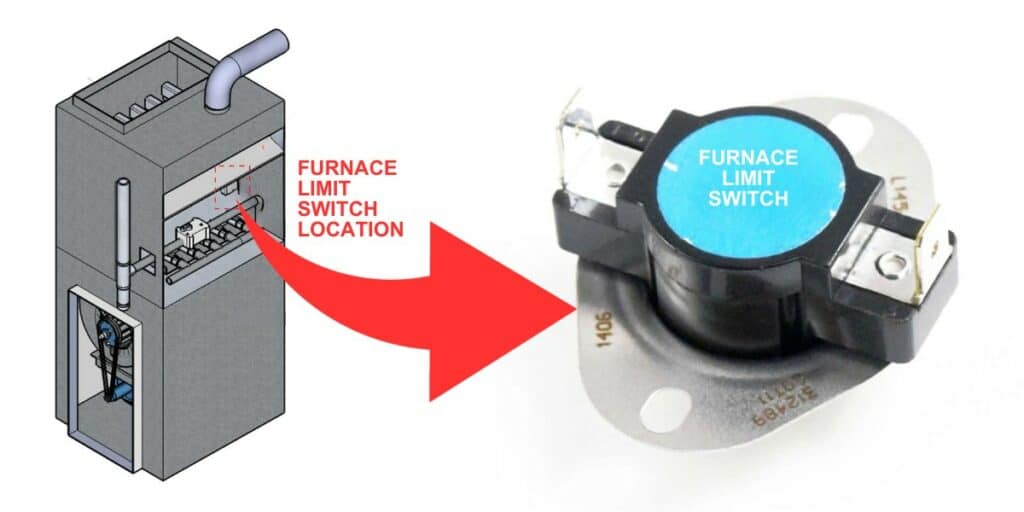The limit switch in a furnace is a critical safety device that prevents overheating by shutting off the burner or the entire furnace if temperatures exceed safe levels. If your furnace isn’t operating correctly—such as not turning on, shutting off prematurely, or blowing cool air—the limit switch may be at fault. Below is a step-by-step guide to checking a furnace limit switch to ensure it’s functioning properly.
What is a Furnace Limit Switch?

The limit switch is typically mounted on the furnace’s plenum or heat exchanger. It monitors the air temperature and signals the blower to turn on or off at specific temperatures. Additionally, it acts as a safety mechanism by shutting down the burner if the furnace overheats.
Signs of a Faulty Furnace Limit Switch
- The furnace runs continuously without heating.
- The blower fan doesn’t turn off.
- The furnace cycles on and off rapidly.
- The furnace fails to ignite.
- Error codes displayed on your thermostat or furnace control board.
What is the most common way to test a limit switch on a furnace?
To check a furnace limit switch, you can:
- Turn on the furnace and let it heat up to the desired temperature.
- Turn the temperature dial all the way down and hold it there for at least three seconds.
- Listen for a click, which means the limit switch is working.
Also check for error codes on the thermostat or furnace control board, which can provide information about overheating or airflow problems.
You can also consider this other way to check your furnace limit switch:
How to Check the Furnace Limit Switch with Multimeter
Tools You’ll Need
- Multimeter (for electrical testing)
- Screwdriver (to access the limit switch)
- Gloves and safety goggles
- Flashlight (optional for better visibility)
Step 1: Ensure Safety
- Turn off power to the furnace at the circuit breaker. This prevents accidental electrical shock during the inspection.
- Wear gloves and safety goggles to protect yourself from sharp edges and electrical components.
Step 2: Locate the Limit Switch
- Open the furnace access panel using a screwdriver. Most panels have screws or clips that secure them in place.
- Find the limit switch, typically a rectangular or round metal component mounted on the furnace’s plenum or heat exchanger. It will have two or three wires connected to it.
Step 3: Inspect the Limit Switch
- Visually check the switch for signs of damage, such as burned or corroded contacts, melted wires, or physical deformities.
- Ensure all wires are securely connected to the terminals.
Step 4: Test the Limit Switch with a Multimeter
- Set your multimeter to the continuity or resistance setting.
- Disconnect the wires connected to the limit switch to isolate it from the furnace circuit.
- Place the multimeter probes on the terminals of the limit switch.
- Normal Functioning Switch: The multimeter will show continuity (a beep or a reading close to zero ohms).
- Faulty Switch: If there is no continuity (infinite resistance), the switch will likely open and must be replaced.
Step 5: Test the Temperature Response (Optional)
- Some limit switches are adjustable or have marked temperature settings. If you suspect the switch isn’t responding to temperature changes, consult the furnace’s manual for the correct specifications.
- You may need a thermometer to verify if the switch activates and deactivates at the correct temperature range. This test requires additional equipment and expertise, so a professional often best handles it.
Replacing a Faulty Furnace Limit Switch
If the limit switch is faulty, replace it with a new one that matches your furnace’s specifications. Follow these steps:
- Disconnect the old switch by removing its mounting screws and unplugging the wires.
- Install the new switch in the same position and reconnect the wires securely.
- Replace the furnace access panel and restore power.
- Test the furnace to ensure it operates correctly.
When to Call a Professional
Contact an HVAC technician if you’re uncomfortable testing the limit switch or if replacing it doesn’t resolve the issue. Persistent problems could indicate underlying issues such as a clogged air filter, malfunctioning blower motor, or blocked vents causing the furnace to overheat.
Ways to Prevent Furnace Limit Switch Problems
- Replace Filters Regularly: A dirty air filter restricts airflow, causing the furnace to overheat. Replace filters at least every 3-6 months during the heating season.
- Keep Vents Clear: Ensure supply and return vents are unobstructed to allow proper airflow.
- Schedule Maintenance: Regular professional maintenance can catch problems before they cause the limit switch to fail.
By following these steps, you can check the condition of your furnace limit switch and address potential issues to keep your furnace running efficiently and safely.






